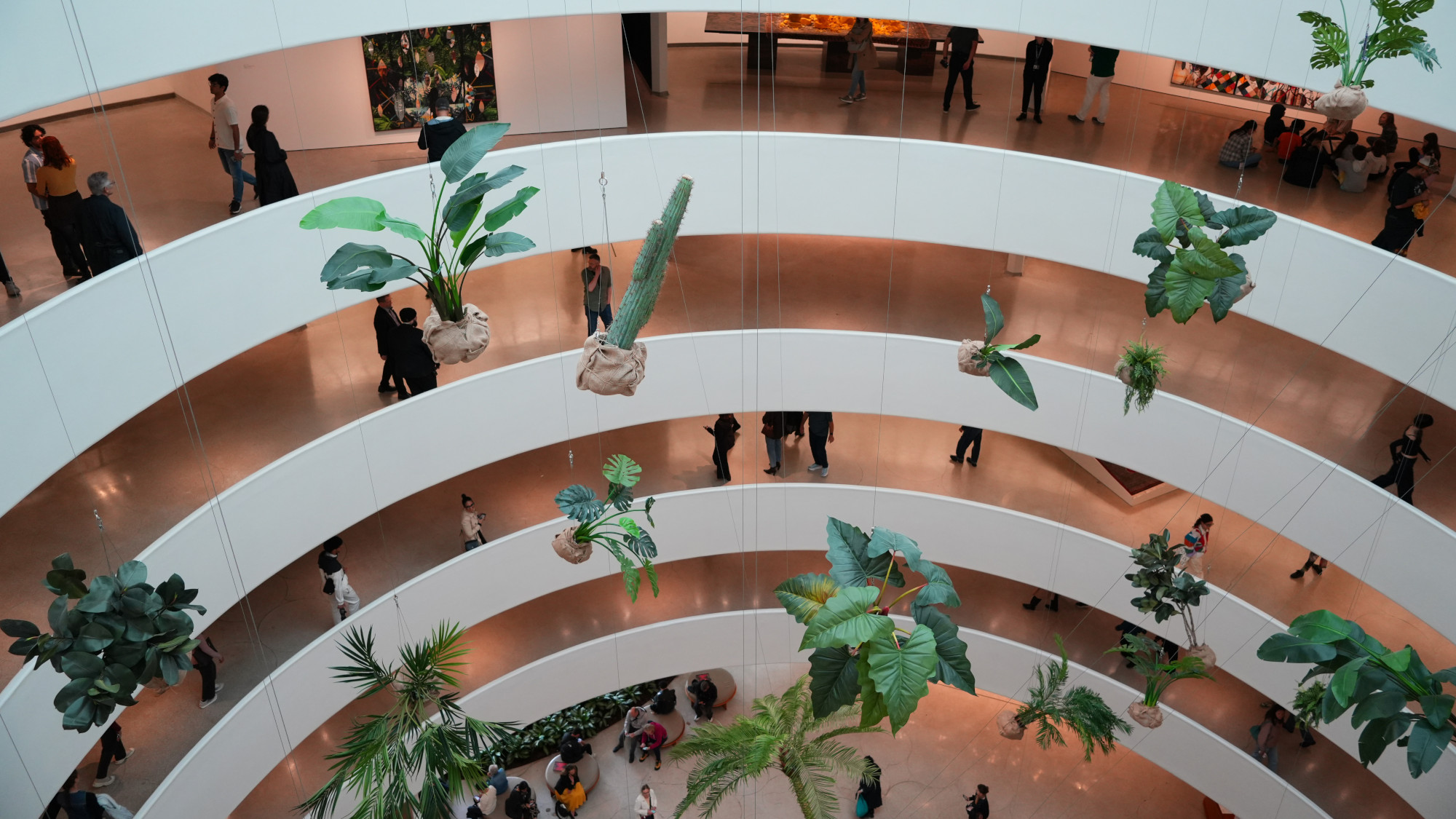Art review: Rashid Johnson: A Poem for Deep Thinkers
Living plants are hung at the Guggenheim in New York City through Jan. 18 as part of Johnson's installation

A "quietly joyous" sight currently greets visitors to the Guggenheim when they look up into Frank Lloyd Wright's famous spiraling rotunda, said Holland Cotter in The New York Times. Illinois-born artist Rashid Johnson has hung living plants from the circular skylight far above, putting the architecture in dialogue with a plant-strewn installation he placed at the top of the spiraling ramp to crown his current mid-career retrospective. But the walk up to that level "brings many changes of mood," because Johnson, 48, works in many media and modes, and "creating an art that offers multiple-choice responses is pretty clearly what he's after." Identified as part of a "post-Black" generation of artists who play with signifiers of Black identity, Johnson first became known for photographs like the pair of large heroic portraits of homeless Black men on display here. From there, he's navigated "a slip-slide between serious and comical" that adds to his work's richness.
"When he hits the mark, you feel the presence of an artist granting himself full scope to ask deep questions," said Sebastian Smee in The Washington Post. "His best works are richly imagined" and incorporate "viscerally engaging" materials. He's "at his best when using crumbly shea butter and glossy black soap on mounted wall pieces" because those common grooming products "speak to self-care as a response to anxiety and even brokenness." But "something about this survey put me in a bad mood," because Johnson seems to be using the freedom he's been granted by the art world to dabble in media, such as painting, that he's not very good at. "Mired in academic thinking," his weakest work is both "too esoteric and too casual." Consider Homage to Chinua Achebe IV (Fela Kuti' Zombie'), a 2004 assemblage that consists of two wooden sleds, one broken in half, and ostensibly references artists Marcel Duchamp and Joseph Beuys, novelist Chinua Achebe, musician Fela Kuti, and Kuti's murdered activist mother. "Can these two sleds carry all that meaning? The answer is no."
Granted, "several of Johnson's works feel like they require a doctorate," said Brian P. Kelly in The Wall Street Journal. Still, "there is much to laud in his wide-ranging practice." And "some of the strongest work here grapples with emotion." A monumental Johnson wall work that greets museum visitors, Untitled Anxious Audience (2019), "features 67 grimacing faces created by pouring black soap and wax on tiles and then carving away the features." The visages evoke both the quiet suffering of people around us and the masks we wear to hide our pain. On the museum's top floor, we eventually encounter a towering installation that suggests a room of shelves packed with plants, books, and ceramics. "It's an apt metaphor for a creative mind overflowing with ideas."
The Week
Escape your echo chamber. Get the facts behind the news, plus analysis from multiple perspectives.

Sign up for The Week's Free Newsletters
From our morning news briefing to a weekly Good News Newsletter, get the best of The Week delivered directly to your inbox.
From our morning news briefing to a weekly Good News Newsletter, get the best of The Week delivered directly to your inbox.
A free daily email with the biggest news stories of the day – and the best features from TheWeek.com
-
 The MAGA civil war takes center stage at the Turning Point USA conference
The MAGA civil war takes center stage at the Turning Point USA conferenceIN THE SPOTLIGHT ‘Americafest 2025′ was a who’s who of right-wing heavyweights eager to settle scores and lay claim to the future of MAGA
-
 The 8 best drama movies of 2025
The 8 best drama movies of 2025the week recommends Nuclear war, dictatorship and the summer of 2020 highlight the most important and memorable films of 2025
-
 Why, really, is Trump going after Venezuela?
Why, really, is Trump going after Venezuela?Talking Points It might be oil, rare minerals or Putin
-
 The strangely resilient phenomenon of stowaways on planes
The strangely resilient phenomenon of stowaways on planesThe Explainer Lapses in security are still allowing passengers to board flights without tickets or passports
-
 The best homes of the year
The best homes of the yearFeature Featuring a former helicopter engine repair workshop in Washington, D.C. and high-rise living in San Francisco
-
 Critics’ choice: The year’s top 10 movies
Critics’ choice: The year’s top 10 moviesFeature ‘One Battle After Another’ and ‘It Was Just an Accident’ stand out
-
 A luxury walking tour in Western Australia
A luxury walking tour in Western AustraliaThe Week Recommends Walk through an ‘ancient forest’ and listen to the ‘gentle hushing’ of the upper canopy
-
 Joanna Trollope: novelist who had a No. 1 bestseller with The Rector’s Wife
Joanna Trollope: novelist who had a No. 1 bestseller with The Rector’s WifeIn the Spotlight Trollope found fame with intelligent novels about the dramas and dilemmas of modern women
-
 Appetites now: 2025 in food trends
Appetites now: 2025 in food trendsFeature From dining alone to matcha mania to milk’s comeback
-
 Man vs Baby: Rowan Atkinson stars in an accidental adoption comedy
Man vs Baby: Rowan Atkinson stars in an accidental adoption comedyTalking Point Sequel to Man vs Bee is ‘nauseatingly schmaltzy’
-
 Goodbye June: Kate Winslet’s directorial debut divides critics
Goodbye June: Kate Winslet’s directorial debut divides criticsTalking Point Helen Mirren stars as the terminally ill English matriarch in this sentimental festive heartwarmer